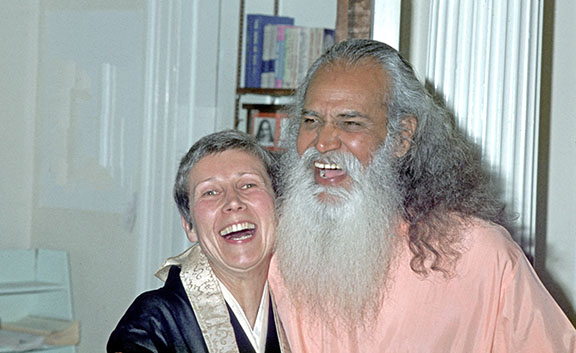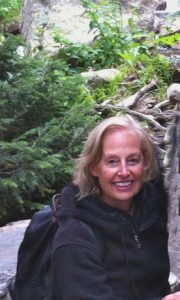 Padma Wick, one of Swami Satchidananda most senior students, reveals the innermost yearnings that took her deep into Zen Buddhism as part of her Integral Yoga path. In this article, she shares her journey through personal stories, conversations with Sri Gurudev, Swami Satchidananda, and teaching parables.
Padma Wick, one of Swami Satchidananda most senior students, reveals the innermost yearnings that took her deep into Zen Buddhism as part of her Integral Yoga path. In this article, she shares her journey through personal stories, conversations with Sri Gurudev, Swami Satchidananda, and teaching parables.
(photo: Sri Swami Satchidananda and Prabhasa Dharma Roshi enjoyed many interfaith programs together for over a decade. Pictured at Satchidananda Ashram-Yogaville East, late 1970s.)
Swami Satchidananda (Gurudev) was my first teacher. I felt completely drawn to him and his teachings and in 1970 moved into the New York IYI. In 1972, Gurudev asked me to accompany him to the “Word Out of Silence” interfaith retreat to teach Yoga classes. True to Gurudev’s interfaith teachings, there was a beautiful sharing of spiritual practices from wonderful teachers including Pir Vilayat Kahn, Br. David Steindl-Rast, Fr. Berry, Alan Watts, Ram Das and Swami Venkatesananda. It was an incredible and formative experience. Sazaki Roshi led daily zazen and held dokusan (audience with the teacher) every morning. Gurudev, Ram Das, and Alan Watts sat zazen across from me and attended dokusan with Sazaki.
Although I was timid and overwhelmed, I didn’t want to miss sitting with this formidable Zen master. Gesshin (who later became the Ven. Prabhasa Dharma Roshi) gave us an introduction and explained the extensive bowing and other protocols. Sazaki Roshi gave a koan: “How do you realize yourself as the Buddha while listening to the sounds of the cricket?” The last day came and I still didn’t have an answer to this koan. But I couldn’t let this opportunity pass. I stumbled into the dokusan room where Sazaki Roshi sat firmly in his black robes. His energy was strong and dense. He said: “Koan please.” In a squeaky voice I repeated the koan. Sazaki: “Answer.” I said: “I don’t know.” Suddenly he became very soft. Opening his arms he said, “Completely the Buddha surrounds you.” I felt a huge weight lifted. I also really appreciated Sazaki and Gesshin’s talks and started reading some books on Zen.
Over the years I developed a strong connection with Gesshin. It was Sri Gurudev’s interfaith approach that introduced me to Zen. I continued with my Yoga practices and teaching Hatha Yoga. Hatha Yoga, the vegetarian diet, and the philosophy and lifestyle of Integral Yoga were very natural to me. I continued mantra practice and had faith in Gurudev. But meditating regularly were not easy in the early years. I started to Zen practice with long sittings, sesshins, and told myself, “No matter how much you want to skip this, just sit still.” I never felt anything lacking in Sri Gurudev or the teachings of Integral Yoga. On the contrary, it was Integral Yoga which gave me the understanding to practice Zen. The formality, and the directness of Zen helped to focus me. There was nothing extra. Eventually this enriched the meditation practice so that today it is a natural, regular, and very important part of my life.
When I decided to take Jukai,“entering the stream,” I asked Gurudev’s blessings. He said, “What none of you have understood, is that all of this is Integral Yoga.” I felt Gurudev gave me the space to have the meditation part of my Integral Yoga practice to be through Zen practice. He nourished his students according to each temperament and taste. He could do that because he was so grounded in samadhi and so universal. I have never felt I was not doing Integral Yoga. In my heart he continues to be incomparable and I am grateful that Zen practice has not been something other than Gurudev, Sri Swami Satchidananda.
In Zen Buddhist practice there is no ground to stand on. Shikantaza Zen practice is formless meditation. No ground to stand on, nothing to achieve. Before Jukai, I read the book, What the Buddha Taught. The author stated that Hindus believe in an Atman (Self) and Buddhists believe in “no self.” I decided to call Gurudev and ask him about that. Gurudev said that when the Buddha was dying, Ananda, who was his chief assistant and disciple, was crying and Buddha asked why he was crying. Ananda said, “All these years you have never spoken about God.” Then, Buddha replied, “Ananda, when have I ever denied God?” So Ananda said, “Then you believe in God? to which Buddha replied, “Ananda, When have I ever affirmed God? Neither accept or reject.” That was Sri Gurudev, the great Zen master, teaching me in a language that spoke to me deeply on a level I cannot explain.
Books such as Moon in a Dew Drop and Zen Mind, Beginners Mind, Return to Silence had a profound impact on me. Phrases like the epitaph for an old Zen master, “Eighty-one years just as it is” fed my practice and my life. Suzuki Roshi’s comment, “Just to see things as they are and to let them go as they go” grounded me.
The etiquette in the zendo (meditation room) supports strong practice. Meditators dressed simply in black or other dark color reduce distraction. Immediately upon entering the zendo, etiquette creates a reverential and meditative space. When entering there is a bow to the Buddha, the left hand is in a fist and the right hand is cupped over it just below the heart chakra. You bow to your cushion as the seat of the Buddha and then you bow to the person across from you as the Buddha. It’s the same respect, honor, and reverence as if you were sitting with Gurudev. During zazen (sitting meditation) the concentration is in the hara (the energy center located just below the navel). The eyes are slightly open so there is no separation between inner and outer world.
What a gift to have been found by Gurudev and his teachings at an early age! Now, at 73 I have an easeful body. Despite the challenges and difficulties that arise in life I am in touch with the peace that Gurudev and the practice of Yoga and Zen have given me.
Each weekday morning before zazen I kneel to put on my rakuso. The rakuso is a small “Buddha’s robe” sewn and received as part of the jukai ceremony. I repeat the prayer,
“Vast is the robe of liberation
A formless field of liberation.
I wear the Tathagatha’s teachings,
Saving all sentient beings.”
Before raising the rakuso over my head to lay it on my shoulders, I touch this “Buddha robe” to my third eye and repeat my mantra, in a personal homage to my Satguru, Swami Satchidananda. He once said, “This person, this body is like a mirror. Do not strive for the approval or smiles of the mirror. Strive to become that which you see. Then and only then will you know the essence of me intimately and recognize my presence and guidance in your heart.”
I am reminded of Gurudev each time I hear this chant:
“The dharma, incredibly profound and infinitely subtle, is rarely encountered even in millions of ages. Now we hear it, see it, receive and maintain it.”
About the Author:

Padma Renke Wick met Swami Satchidananda in 1970 and served as corresponding secretary at the New York Integral Yoga Institute during its early days. Over the years, she has taught Integral Yoga and contributed to Sri Swamiji’s interfaith service organizing several “Unity in Diversity” conferences. Padma has two grown sons, Ganesh and Muruga, and four grandchildren. She and her husband, Vishnu, live in Longmont, Colorado. Padma regularly practices Zen with the Eon Zen Center in Boulder and meditates with the household at the San Francisco Integral Yoga Institute several times a year.

